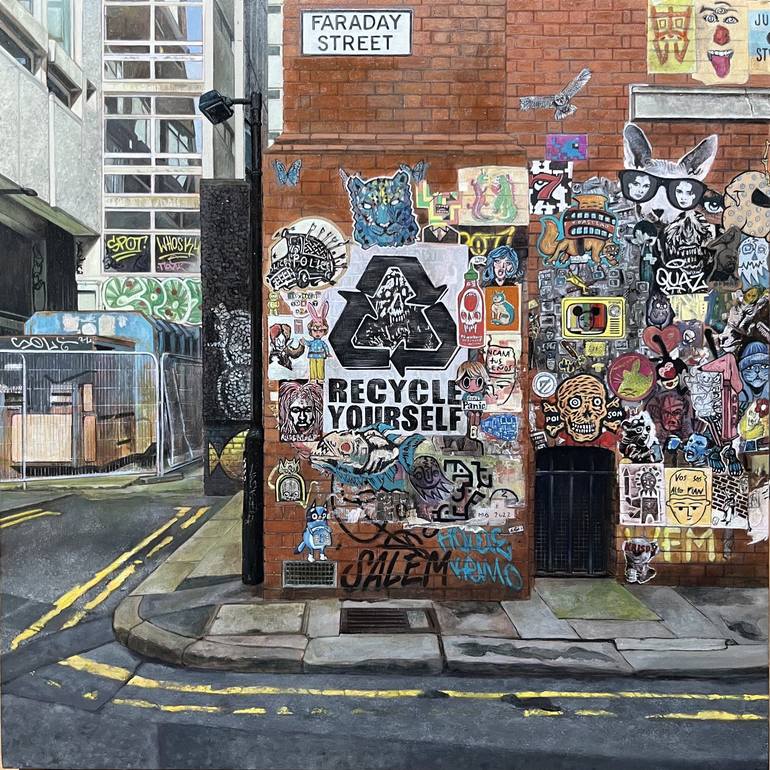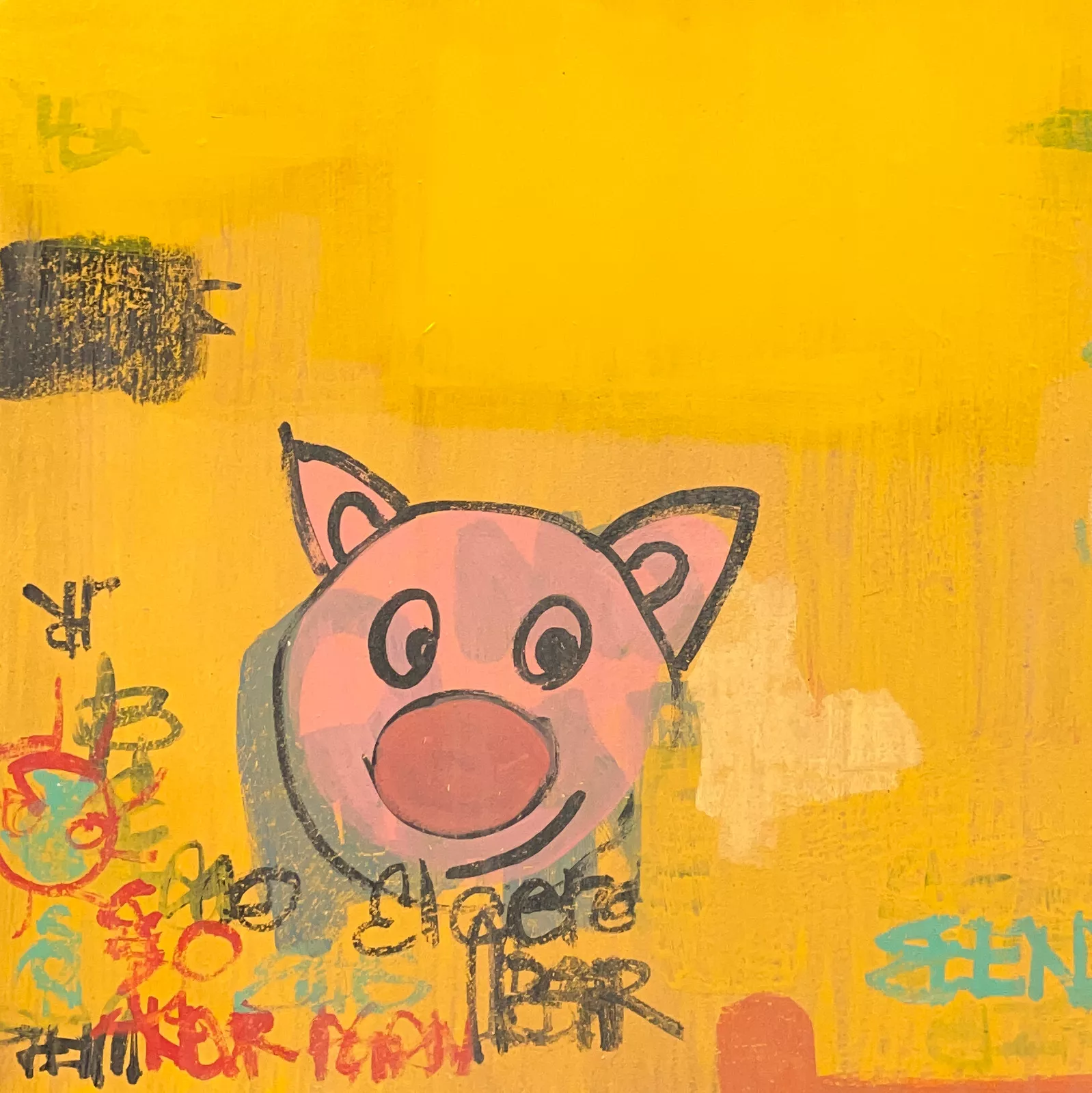Some paintings arrest us not by grandeur or overt emotion, but by quiet precision—the kind that breathes in long backdrops and empty streets. Faraday Street II by Ryan Everson, a member of the Royal Birmingham Society of Artists (RBSA), belongs to this category. It is a work of restraint, balance, and extraordinary stillness, set against the backdrop of British urban realism.
In an era saturated with spectacle and abstraction, Faraday Street II is a meditation on the everyday: a portrait not of people, but of place. It captures a British city street with painterly attention to light, structure, and the subtle lyricism of silence. This piece is not just a representation—it is an experience.
The Scene Itself: Composition and Quietude
At first glance, Faraday Street II presents a familiar urban vista—perhaps Birmingham, Manchester, or another mid-sized British city where red-brick facades, lamp posts, and tight roads converge. But what makes the painting striking is its absence of motion. There are no cars, no pedestrians, no clutter. The street is entirely empty, yet not desolate. It feels like early morning, or perhaps a Sunday, when the city holds its breath.
The composition is guided by strong linear perspective: buildings flank both sides of the street, converging at a central vanishing point that pulls the viewer inward. The verticality of lamp posts and windows is mirrored in the quiet rhythm of brickwork and rooflines. Light enters diagonally—perhaps late afternoon sun or early winter rays—casting long, gentle shadows and emphasizing architectural detail.
This is a street that could be anywhere, and yet it is unmistakably British. There is a vernacular charm to the building styles: a mix of Victorian industrial, mid-century utilitarian, and small commercial forms, rendered not with exaggeration but with clear-eyed affection.
Everson’s Palette: Muted Precision
One of the most striking elements of Faraday Street II is its color palette. Everson avoids romantic tones or heavy contrasts. Instead, he uses a restrained spectrum of greys, browns, burgundies, and washed-out blues. These colors evoke a specific mood—the dull gleam of wet stone, the softness of cloudy light, the wear of aging brick.
The sky is pale, almost washed clean of color, functioning more as an atmosphere than a subject. Backgrounds are subtle, but deliberate—nothing overly dramatic, but everything considered. The palette reflects not just a scene, but a cultural temperament: the stoicism, clarity, and understatement often associated with British realism.
Realism Without Nostalgia
Unlike certain urban painters who lean into nostalgia—casting the city as a place of lost glory or poetic decay—Everson remains matter-of-fact, even sober in his tone. Faraday Street II does not beg for sentiment. Instead, it asks for attention. It encourages viewers to notice the details they might otherwise pass: the texture of mortar between bricks, the angle of a curb, the subtle dent in a rolling shutter.
This level of observation places Everson within a long lineage of British documentary realism, recalling figures such as L.S. Lowry, John Atkinson Grimshaw, and Leon Kossoff—though with a cleaner, more photographic precision. While Lowry populated his cities with stick-like crowds and smoke, Everson empties his. While Kossoff’s brushwork exploded with energy and mass, Everson’s is quiet and meticulous.
If anything, Faraday Street II is closer in spirit to the photorealists or the superrealists of the late 20th century, but with more air, more light, and less concern for surface sheen. It is a painting rooted in observation rather than spectacle.
The Emotional Architecture of Urban Space
What emotion does Faraday Street II evoke? On the surface, one might say calm, or even melancholy. But linger longer, and more complex sensations arise: contemplation, privacy, order, and perhaps even a kind of metaphysical solitude. It is a painting about space and its emotional consequences.
The street’s emptiness does not imply vacancy, but potential. We are placed not as viewers but as walkers—as solitary presences entering the scene from the front edge of the painting. There is an invitation to walk further, to explore what lies around the corner or beyond the horizon.
This sense of gentle solitude is rare in contemporary painting, especially when addressing urban environments. The city, in Everson’s hands, is not noisy, chaotic, or impersonal—it is knowable, rhythmic, and architectural. This is not the dystopian city of crumbling tower blocks or neon loneliness, but a space with memory, dignity, and restraint.
British Traditions, Contemporary Voice
Ryan Everson’s work resonates within a wider trajectory of British painting that values place-based specificity. Artists like George Shaw, known for his enamel depictions of Coventry suburbia, or Rachel Whiteread, whose sculptural casts of domestic spaces evoke absence and memory, similarly engage with the overlooked textures of daily life.
But unlike Shaw’s often mournful tone or Whiteread’s conceptual remove, Everson offers something more immediate: a visual intimacy with the city. He seems to suggest that painting remains a way of looking slowly, with care, and that urban space, despite its functionality, holds the potential for quiet lyricism.
As a member of the Royal Birmingham Society of Artists, Everson also contributes to a regional tradition of celebrating Midlands architecture and light. In this way, Faraday Street II can be seen as a portrait not of a place exactly, but of a mode of seeing that is attentive, patient, and deeply rooted in the observational school.
Light as Subject
Light in Everson’s painting is not merely a technical device—it is a subject in itself. The painting would not be the same under fluorescent conditions, nor in the golden hour. Here, the light is clear but softened, possibly filtered through low clouds or winter air. It falls evenly, allowing surfaces to reveal their texture without overwhelming them.
The conjure between backdrop and light helps define the geometry of the scene: gutters, sills, doorways, signs. Yet none of it feels staged. The light is not dramatized, but naturalized. It feels lived.
In this sense, Faraday Street II recalls Edward Hopper’s treatment of architectural solitude, though with less theatricality. Hopper’s silence often borders on existential dread; Everson’s silence feels settled, even benevolent.
The Absence of People, The Presence of Place
One notable feature of Faraday Street II is the total absence of figures. This decision may seem counterintuitive—after all, cities are defined by human activity. But Everson chooses to omit people, allowing the built environment to speak.
This emptiness is not alienating; it creates room for the viewer to project. We are given space to enter the scene not as spectators but as participants. In this way, the painting becomes introspective, encouraging not only observation but meditation.
The effect is akin to the haiku form in poetry: minimal, distilled, but resonant. Everything is in place. Nothing is extraneous. What remains is essence.
Technique and Surface
Technically, Faraday Street II demonstrates meticulous craftsmanship. Everson’s brushwork is likely fine and controlled—possibly blended to near invisibility. Edges are clean but not clinical; lines are deliberate without stiffness. There is a balance between painterly presence and photographic exactitude.
The surface of the work, though not visible in this editorial, is likely matte or semi-matte, preventing reflection and maintaining focus on the image itself. This tactile modesty reinforces the thematic modesty of the scene: the surface and subject are both understated but carefully constructed.
Impression
In Faraday Street II, Ryan Everson has created more than an image of a street. He has constructed a space for pause. At a time when contemporary art often competes for attention, volume, and spectacle, this painting does the opposite. It asks the viewer to stop, to stay, and to look closely.
Its power lies not in drama, but in stillness. Its language is not overt, but architectural, chromatic, and spatial. Everson does not shout. He listens. And in doing so, he reveals something essential about how we live in and move through cities—not as tourists or consumers, but as quiet participants in the ongoing theater of space and time
No comments yet.








